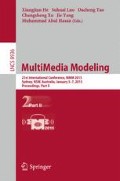Abstract
With the popularization of smart phones, Quick Response (QR) code becomes one of the most widely used two-dimensional barcodes. Standard QR code consists of black and white squares (called modules) and its noise-like appearance would seriously disrupt the aesthetic appeal of its carrier, e.g., a poster. To make QR code more aesthetic, this paper proposes an automatic approach for blending a visual-unattractive QR code with a background image. This approach consists of two stages: module-based blending and pixel-based blending. At the first stage, a binary aesthetic QR code is generated module by module. At the second stage, a color aesthetic QR code is further generated pixel by pixel. The advantages of our approach are: 1) greatly enhancing the aesthetic appearance of the original QR code, 2) maintaining the error correction capacity of the standard QR code, 3) allowing full-area blending of various photographs, drawings and graphics. Experimental results demonstrate that our approach produces high quality QR codes in terms of both visual appearance and readability.
Access this chapter
Tax calculation will be finalised at checkout
Purchases are for personal use only
Preview
Unable to display preview. Download preview PDF.
References
Samretwit, D., Wakahara, T.: Measurement of reading characteristics of multiplexed image in QR code. In: International Conference on Intelligent Networking and Collaborative Systems, pp. 552–557. IEEE (2011)
Ono, S., Morinaga, K., Nakayama, S.: Animated two-dimensional barcode generation using optimization algorithms-redesign of formulation, operator, and quality evaluation. Journal of Advanced Computational Intelligence and Intelligent Informatics 13(3), 245–254 (2009)
Alva, N., Uriel, P., Itama, F.: Visualead (2012), http://www.visualead.com
Chu, H.K., Chang, C.S., Lee, R.R., Mitra, N.J.: Halftone QR codes. ACM Transactions on Graphics 32(6), 217–224 (2013)
Baharav, Z., Kakarala, R.: Visually significant QR codes: Image blending and statistical analysis. In: International Conference on Multimedia and Expo, pp. 1–6. IEEE (2013)
Cox, R.: Qart codes (2012), http://research.swtch.com/qart
Lin, Y.-H., Chang, Y.-P., Wu, J.-L.: Appearance-based QR code beautifier. IEEE Transactions on Multimedia 15(8), 2198–2207 (2013)
Skawattananon, C., Ketcham, M., Vongpradhip, S.: Identifying QR code. In: International Conference on Computer and Communication Technologies, pp. 132–135 (2012)
Lin, Y.S., Luo, S.J., Chen, B.Y.: Artistic QR code embellishment. In: Computer Graphics Forum, pp. 137–146 (2013)
Garateguy, G.J., Arce, G.R., Lau, D.L., Villarreal, O.P.: QR images: optimized image embedding in QR codes. IEEE Transactions on Image Processing 23(7), 2842–2853 (2014)
Fang, C., Zhang, C., Chang, E.-C.: An optimization model for aesthetic two-dimensional barcodes. In: Gurrin, C., Hopfgartner, F., Hurst, W., Johansen, H., Lee, H., O’Connor, N. (eds.) MMM 2014, Part I. LNCS, vol. 8325, pp. 278–290. Springer, Heidelberg (2014)
Wakahara, T., Samretwit, D., Maki, T., Yamamoto, N.: Design and characteristics of two-dimensional color code editor with dotted images. In: Information Technology Convergence, pp. 323–332. Springer (2013)
Fujita, K., Kuribayashi, M., Morii, M.: Expansion of image displayable area in design QR code and its applications. In: Forum on Information Technology, pp. 517–520 (2011)
Cheng, M.-M., Warrell, J., Lin, W.-Y., Zheng, S., Vineet, V.: Efficient salient region detection with soft image abstraction. In: International Conference on Computer Vision, pp. 1529–1536. IEEE (2013)
Author information
Authors and Affiliations
Editor information
Editors and Affiliations
Rights and permissions
Copyright information
© 2015 Springer International Publishing Switzerland
About this paper
Cite this paper
Zhang, Y., Deng, S., Liu, Z., Wang, Y. (2015). Aesthetic QR Codes Based on Two-Stage Image Blending. In: He, X., Luo, S., Tao, D., Xu, C., Yang, J., Hasan, M.A. (eds) MultiMedia Modeling. MMM 2015. Lecture Notes in Computer Science, vol 8936. Springer, Cham. https://doi.org/10.1007/978-3-319-14442-9_16
Download citation
DOI: https://doi.org/10.1007/978-3-319-14442-9_16
Publisher Name: Springer, Cham
Print ISBN: 978-3-319-14441-2
Online ISBN: 978-3-319-14442-9
eBook Packages: Computer ScienceComputer Science (R0)

